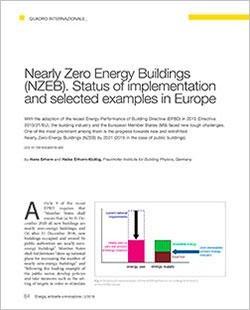
Nearly Zero Energy Buildings (NZEB). Status of implementation and selected examples in Europe
by Hans Erhorn and Heike Erhorn-Kluttig - Fraunhofer Institute for Building Physics, Germany
DOI 10.12910/EAI2016-032
With the adoption of the recast Energy Performance of Building Directive (EPBD) in 2010 (Directive 2010/31/EU), the building industry and the European Member States (MS) faced new tough challenges. One of the most prominent among them is the progress towards new and retrofitted Nearly Zero-Energy Buildings (NZEB) by 2021 (2019 in the case of public buildings)
Article 9 of the recast EPBD requires that “Member States shall ensure that (a) by 31 December 2020 all new buildings are nearly zero-energy buildings; and (b) after 31 December 2018, new buildings occupied and owned by public authorities are nearly zero-energy buildings”. Member States shall furthermore “draw up national plans for increasing the number of nearly zero-energy buildings” and “following the leading example of the public sector, develop policies and take measures such as the setting of targets in order to stimulate the transformation of buildings that are refurbished into nearly zero-energy buildings”.
A NZEB is defined in article 2 of the Directive 2010/31/EU as “a building that has a very high energy performance... . The nearly zero or very low amount of energy required should be covered to a very significant extent by energy from renewable sources, including energy from renewable sources produced on-site or nearby”. …

